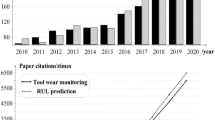Abstract
Condition monitoring and fault diagnosis of working machine become increasingly important during the manufacturing process because they are closely related to the quality of product. In the meanwhile, they are crucial for early fault diagnosis of rolling element bearing (REB) as a machine always works in an off-design condition for machine tools. The key issue of REB early fault diagnosis is the optimal frequency band determination based on envelope analysis. In this research, a new method is proposed to determine the best frequency band for REB fault diagnosis by using a reference signal to determine the analyzed frequency band. The best frequency band is obtained according to the variance by comparing current condition with a normal one. To verify the effectiveness of this method, simulation signal and experimental signal in the test rig are applied for investigation. As well, practical monitored REB early fault diagnosis is also investigated to verify the effectiveness of this method. It can be concluded that this method can improve the accuracy for pattern recognition and benefit the development of REB fault diagnosis for manufacturing machines. This method assists us to develop an REB early fault diagnosis system, which is suitable for industrial application according to monitored REB condition investigation.

















Similar content being viewed by others
References
Adib, A., & Aboutajdine, D. (2005). Reference-based blind source separation using a deflation approach. Signal Processing, 85(10), 1943–1949.
Antoni, J. (2006). The spectral kurtosis: A useful tool for characterising non-stationary signals. Mechanical Systems and Signal Processing, 20(2), 282–307.
Antoni, J. (2007). Fast computation of the kurtogram for the detection of transient faults. Mechanical Systems and Signal Processing, 21(1), 108–124.
Antoni, J., & Randall, R. B. (2006). The spectral kurtosis: Application to the vibratory surveillance and diagnostics of rotating machines. Mechanical Systems and Signal Processing, 20(2), 308–331.
Barszcz, T., & Jablonski, A. (2011). A novel method for the optimal band selection for vibration signal demodulation and comparison with the Kurtogram. Mechanical Systems and Signal Processing, 25(1), 431–451.
Braun, S. (1996). Mechanical signature analysis: Theory and applications. New York: Academic Press.
Combet, F., & Gelman, L. (2009). Optimal filtering of gear signals for early damage detection based on the spectral kurtosis. Mechanical Systems and Signal Processing, 23(3), 652–668.
Dwyer, R. F. (1983). A technique for improving detection and estimation of signals contaminated by under ice noise. Journal of the Acoustical Society of America, 74(1), 124–130.
Dyer, D., & Stewart, R. M. (1978). Detection of rolling element bearing damage by statistical vibration analysis. Journal of Mechanical Design-Transactions of the ASME, 100(2), 229–235.
Hou, T. H., Liu, W. L., & Lin, L. (2003). Intelligent remote monitoring and diagnosis of manufacturing processes using an integrated approach of neural networks and rough sets. Journal of Intelligent Manufacturing, 14(2), 239–253.
Hu, H. S., Li, Z. W., & Abdulrahman, A. A. (2011). Reversed fuzzy Petri nets and their application for fault diagnosis. Computers and Industrial Engineering, 60(4), 505–510.
Jardine, A. K. S., Lin, D., & Banjevic, D. (2006). A review on machinery diagnostics and prognostics implementing condition-based maintenance. Mechanical Systems and Signal Processing, 20(7), 1483–1510.
Jin, J. H., & Shi, J. J. (2001). Automatic feature extraction of waveform signals for in-process diagnostic performance improvement. Journal of Intelligent Manufacturing, 12(3), 257–268.
Kappaganthu, K., & Nataraj, C. (2011). Feature selection for fault detection in rolling element bearings using mutual information. Journal of Vibration and Acoustics-Transactions of the ASME, 133(6), 061001.1–061001.11.
Lei, Y. G., Lin, J., He, Z. J., & Zi, Y. Y. (2011). Application of an improved kurtogram method for fault diagnosis of rolling element bearings. Mechanical Systems and Signal Processing, 25(5), 1738–1749.
Li, H. K., Zhou, P. L., Zhang, Z. X. (2010). An investigation into machine pattern recognition based on time-frequency image feature extraction using a support vector machine. Proceedings of the Institution of Mechanical Engineers Part C-Journal of Mechanical Engineering Science, 224(C4), 981–994.
Li, R. Y., Sopon, P., & He, D. (2012). Fault features extraction for bearing prognostics. Journal of Intelligent Manufacturing, 23(2), 313–321.
Lin, J., & Zuo, M. J. (2003). Gearbox fault diagnosis using adaptive wavelet filter. Mechanical Systems and Signal Processing, 17(6), 1259–1269.
Ma, C., Li, H. K., Zhao, L. H., & Guo, Z. G. (2011). Rolling bearing fault diagnosis using wavelet paclet-kurtosis-envelope. Journal of Vibration, measurement and Diagnosis, 31(6), 720–723.
Mallat, S. G. (2003). A wavelet tour of signal processing: The sparse way (3rd ed.). New York: Academic Press.
Megahed, F. M., & Camelio, J. A. (2012). Real-time fault detection in manufacturing environments using face recognition techniques. Journal of Intelligent Manufacturing, 23(3), 393–408.
Onel, I. Y., Aycicek, E., & Senol, I. (2009). An experimental study about detection of bearing defects in inverter fed small induction motors by Concordia transform. Journal of Intelligent Manufacturing, 20(2), 243–247.
Randall, R. B., & Antoni, J. (2011). Rolling element bearing diagnostic-A tutorial. Mechanical Systems and Signal Processing, 25(2), 485–520.
Siegel, D., Al-Atat, H., Shauche, V., Liao, L. X., Snyder, J., & Lee, J. (2012). Novel method for rolling element bearing health assessment-a tachometer-less synchronously averaged envelope feature extraction technique. Mechanical Systems and Signal Processing, 29, 362–376.
Sun, Z.-L., & Shang, L. (2010). An improved constrained ICA with reference based unmixing matrix initialization. Neurocomputing, 73(4–6), 1013–1017.
Xu, Y. S., & Ge, M. (2004). Hidden Markov model-based process monitoring system. Journal of Intelligent Manufacturing, 15(3), 337–350.
Acknowledgments
The work was supported by the Natural Science Foundation of China under Grant No 51175057 and the National Basic Research Program of China under Grant No 2012CB026000.
Author information
Authors and Affiliations
Corresponding author
Rights and permissions
About this article
Cite this article
Li, H., Lian, X., Guo, C. et al. Investigation on early fault classification for rolling element bearing based on the optimal frequency band determination. J Intell Manuf 26, 189–198 (2015). https://doi.org/10.1007/s10845-013-0772-8
Received:
Accepted:
Published:
Issue Date:
DOI: https://doi.org/10.1007/s10845-013-0772-8




